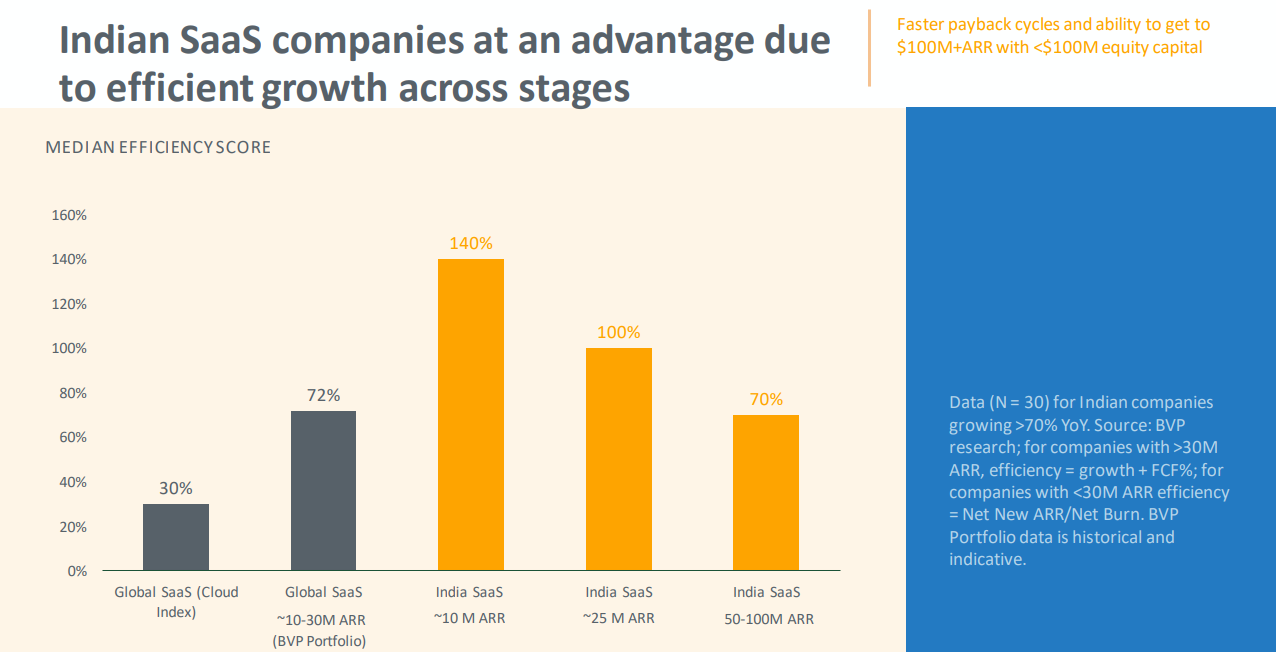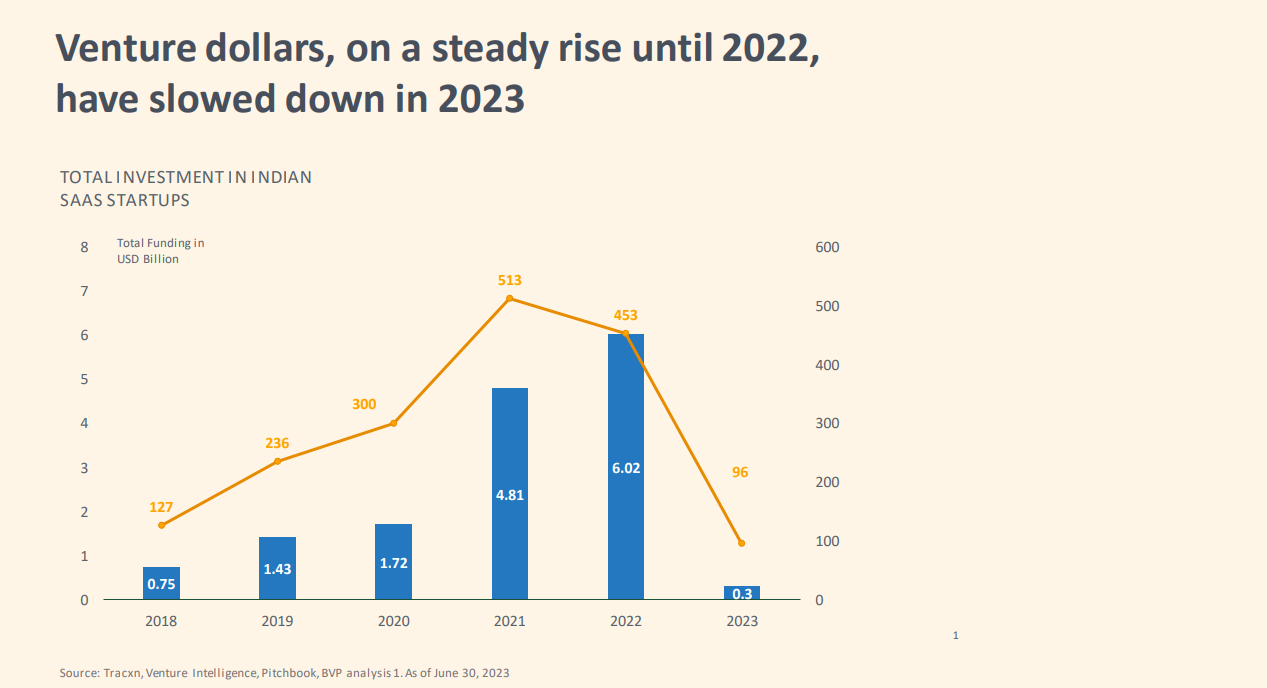
Indian software-as-a-service (SaaS) companies would end up achieving the same scale of revenue by 2030 as indicated in the previous year despite decreased funding owing to the macroeconomic conditions, venture capital firm Bessemer Venture Partners (BVP) said in a report.
The main reason for this is the high-efficiency scores of Indian SaaS companies—an indication of the amount that needs to be spent to earn a particular amount of money—when compared to their global counterparts.
“Hopefully, most of the companies will have raised less than $100 million to get to a $100 million in ARR (annual recurring revenue). It’s the amount of capital consumed because they may have raised more, which they will use for further growth. But the amount of money that they have burned till that point will be less than a $100 million in capital is what I believe,” said Anant Vidur Puri, Partner at BVP.
ARR refers to the amount of money a SaaS firm can expect to generate from its customers every year—an important metric to assess its financial health.
The report added that in a high-interest rate regime, the valuations of businesses decline, and there are higher expectations of return on investments. It implies that companies with high growth rates and free cash flows gain favour in such an environment.
And, efficiency for mature SaaS companies is nothing but adding growth rates and free cash flow percentages, and for early-stage firms, it is net new ARR by net burn.
<figure class="image embed" contenteditable="false" data-id="523015" data-url="https://images.yourstory.com/cs/2/464cfc80fc4b11ec863f3b2095783040/IndianSaaSefficiency-Bessemer-1691423156861.png" data-alt="Efficiency of Indian SaaS companies 2023" data-caption="
Source: ‘Rise of SaaS in India 2023’ report by Bessemer Venture Partners
” align=”center”>
Source: ‘Rise of SaaS in India 2023’ report by Bessemer Venture Partners
BVP reiterated its last year’s stance on how Indian SaaS companies are more efficient than global companies due to a couple of reasons: lower cost base and the country’s inherent cultural competence/effectiveness.
Some of the ways Indian SaaS companies are efficient are by adding products to their existing set of offerings, adding engineering to sell more to the existing customers, doing multiple iterations in a short period of time, and selling added features to existing customer base to increase growth rates and net retention numbers (the ability to retain revenue from existing customers over a period of time).
The report estimates that the market size of Indian SaaS would grow from $13 billion in 2022 to $25 billion by 2025, $35 billion by 2027, and $50 billion by 2030. BVP has maintained the $50 billion forecast for 2030 at the same level as last year.
Together, Indian SaaS centaurs ($100 million in ARR) and unicorns are expected to earn about $22 billion in revenue in 2030—more than 5X the revenue recorded in 2021 ($3.9 billion). Though no new unicorns have emerged in the Indian SaaS ecosystem in 2023 thus far, it has given rise to 11 centaurs in 2022 compared to nine in 2021 and two in 2015, respectively.
Across different ARR buckets, the number of SaaS companies has increased in 2022 compared to the previous year.
The report has five predictions for the Indian SaaS ecosystem. First, as a result of the higher efficiency scores of the Indian firms, more capital will flow to the ecosystem and “aid them on their path to global leadership”. For context, venture funding in the segment increased from $4.8 billion in 2021 to $6 billion in 2022 compared to just $0.3 billion so far this year, according to the report.
<figure class="image embed" contenteditable="false" data-id="523016" data-url="https://images.yourstory.com/cs/2/464cfc80fc4b11ec863f3b2095783040/IndianSaaSfunding-Bessemer-1691423337098.png" data-alt="Indian SaaS funding in 2023" data-caption="
Source: ‘Rise of SaaS in India 2023’ report by Bessemer Venture Partners
” align=”center”>
Source: ‘Rise of SaaS in India 2023’ report by Bessemer Venture Partners
Second is that new cloud infrastructure will emerge to power the traditional financial services sector, and third, UPI—estimated to fuel person-to-merchant transactions to over a trillion-dollar market by 2026—will give rise to SaaS and infrastructure creation opportunities.
The fourth prediction is that the Indian pharmaceutical industry is expected to gravitate towards cloud software propelled by regulatory changes, while the fifth and last one talks about the widespread adoption of artificial intelligence (AI).
The report, quoting an independent statistic, said India has the highest percentage of developers using AI followed by Brazil, the US, the UK, and Germany. It added that India is “the leading hub of open-source AI projects”.
Indicating that the emergence of large language models is just the beginning and can be likened to the “AWS moment for AI”, the report said that the best-in-class companies would use humans and AI, and AI-first Indian companies would “lead productisation of services locally and globally”.
Edited by Suman Singh






![Read more about the article [Tech50] How this gaming platform merges fantasy with knowledge](https://blog.digitalsevaa.com/wp-content/uploads/2022/01/TENTOFEEATURE-1641284840214-300x150.jpg)



